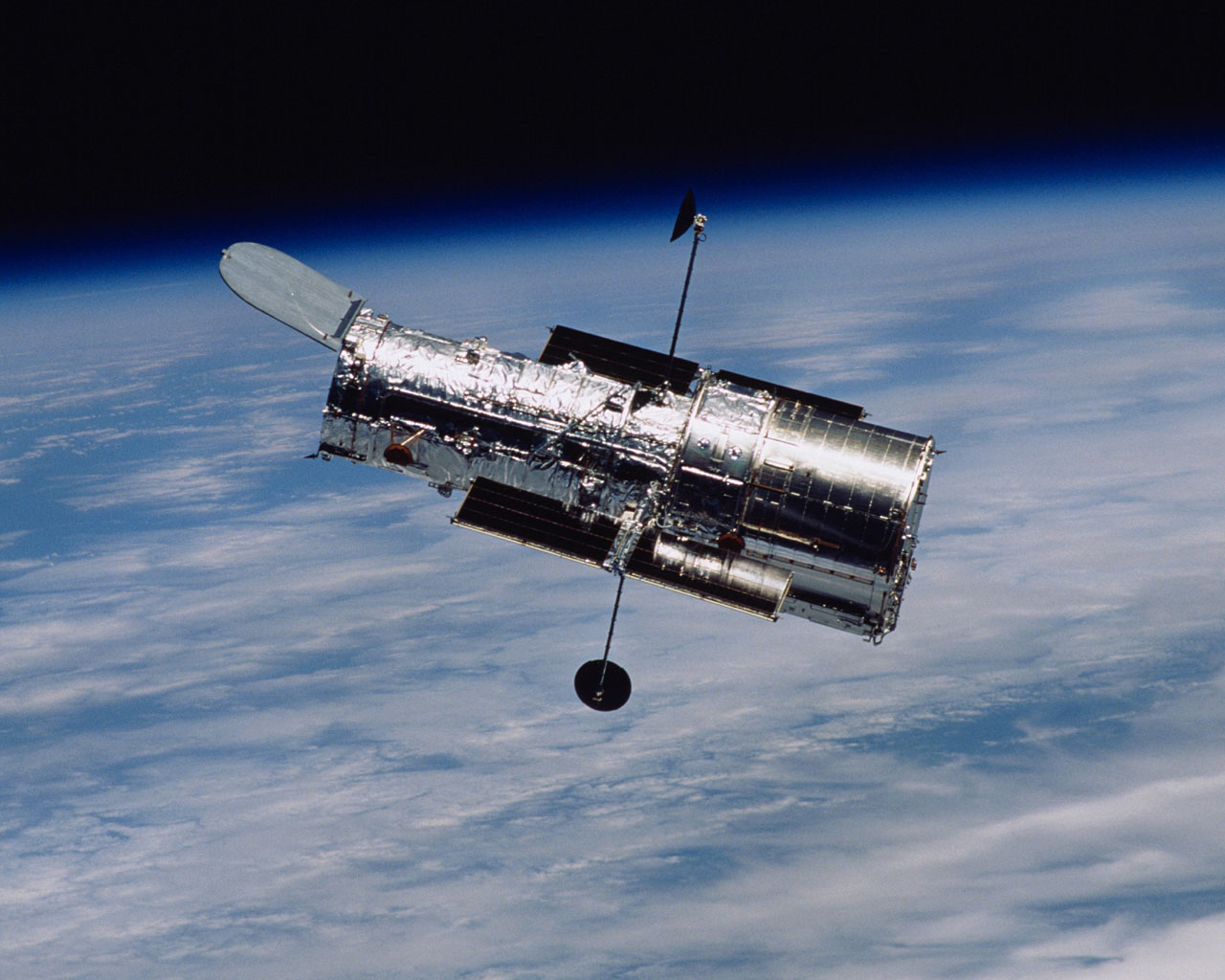
“All truths are easy to understand once they are discovered; the point is to discover them.”
Galileo Galilei (1564-1642)
In the words of a famous Chinese proverb, “The journey of a thousand miles begins with one step.” Likewise, most of the great intellectual and spiritual revolutions and paradigm shifts that have shaped the course of human history were characterised by small and humble beginnings, the importance of which was originally seen as inconsequential at the time. Similarly, the history of physics and astronomy is also characterised by events that have forever changed the way we view the world, from Isaac Newton’s formulation of the laws of motion and Galileo’s first telescopic observations of the night sky in the 17th century, to Albert Einstein’s development of the theories of special and general relativity and Edwin Hubble’s discoveries about the scale and expansion of the Universe in the early 20th century.
A similar widening of humanity’s perception of the Universe has also taken place in recent years, courtesy of NASA’s Hubble Space Telescope. The iconic space observatory, which celebrates 25 years in orbit this month, has made more than one million observations of the Universe to date, which have helped scientists and non-scientists alike to truly visualise the notion of the infinity of space and time, like no other instrument before it. The cutting-edge science that has been conducted by the orbiting observatory during this time has exceeded all expectations, resulting in the publication of more than 12,700 papers in the scientific literature worldwide, which have completely transformed almost every research area of cosmology astronomy and astrophysics. At the same time, Hubble has returned images of the Cosmos of unparalleled aesthetic beauty that have been the wallpapers of choice on the computer screens of millions of people around the world, helping to also change the public’s view of the Universe in the process. “Hubble has in so many ways completely revolutionised our understanding of the Universe,” remarked Dr. Amber Straughn, an Astrophysicist at NASA’s Goddard Space Flight Center in Greenbelt, Md., during a recent commemorative talk at the Museum of Flight in Washington, for Hubble’s upcoming 25th anniversary. “It changed the way that we as astronomers understand space. But even more than that, I think on a more profound level it changed the way that humanity thinks about space. Before Hubble, people thought of space as [being] dark and void. After Hubble, people think of space as [being] colorful and beautiful. And I think that this very subtle shift in how people generally think about space is really profound and it speaks to the significance that Hubble has had on our culture.”
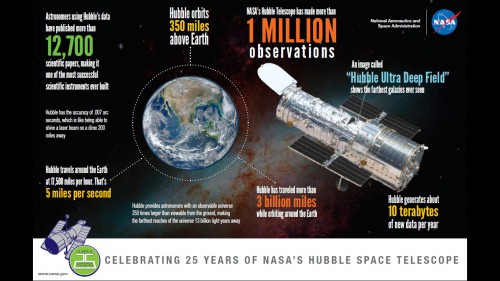
The full breadth of Hubble’s observations of the Cosmos would require many volumes in order to be adequately presented. Even though this exceeds by far the scope of just one article, this AmericaSpace series nevertheless aims to present some of the most important cosmic discoveries ever made by the Hubble space telescope, as well as the iconic images that accompany them, in order of increasing distance from Earth.
New Views of Familiar Planetary Vistas
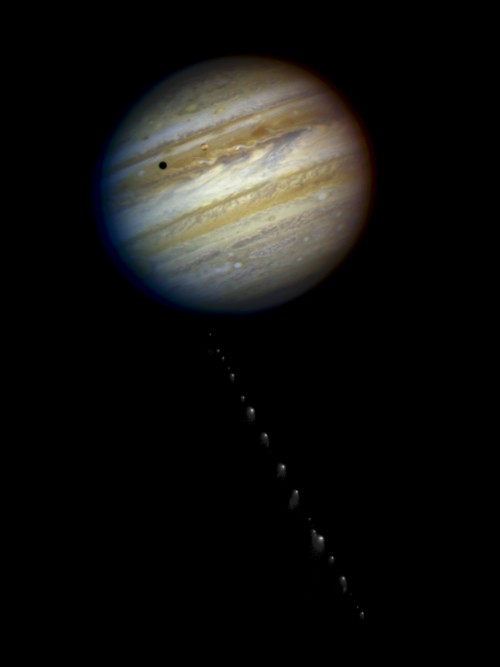
The start of 1994 heralded a new beginning for the Hubble Space Telescope as well as for astronomy in general. Having already been repaired in orbit by the crew of the STS-61 mission in December of the previous year, which had triumphantly succeeded in correcting its originally impaired vision, the orbiting observatory had already started to send back images of deep space that had all the clarity and resolution that astronomers had hoped for. Nevertheless, during the summer of 1994 scientists and the public alike were treated to a cosmic fireworks display, the likes of which had never been observed before in human history. Comet Shoemaker-Levy 9, which had been discovered several months prior the launch of the first Hubble servicing mission, was found to be on a collision course with Jupiter, giving astronomers a first-rate chance to witness the event live as it progressed. Having been broken up into a total of 21 large fragments by the massive gravity of the gas giant planet, Shoemaker-Levy 9 finally impacted piece by piece onto the cloud tops of Jupiter’s southern hemisphere between July 16 and July 22, 1994, releasing the energy equivalent of several million megatons of TNT in the process.
Hubble’s Wide Field Planetary Camera-2 was able to make detailed observations of the planet-sized impact sites in optical and ultraviolet wavelengths, providing scientists with their first direct measurements of the planet’s atmospheric composition below the visible cloud tops. Spectroscopic analysis of the results revealed the presence of molecules like sulfur, carbon disulfide, hydrogen sulfide, and ammonia, while also finding that Jupiter’s atmospheric abundances of molecules like water and hydroxyl were much lower than expected, contrary to the predictions of planetary scientists. Furthermore, Hubble’s Faint Object Spectrograph recorded dramatic changes in the planet’s massive magnetosphere while the latter was penetrated by the comet’s fragments, resulting in large electromagnetic disturbances along Jupiter’s magnetic field lines which temporarily generated unexpectedly bright aurorae. But perhaps one of the more important lessons to be learned from Shoemaker-Levy 9’s impact on Jupiter was the role that asteroids and comets play in the evolution of planetary systems, as both the carriers of life and the bringers of doom. “More than anything else, this comet taught us about the role that impacts have played in the history of the Solar System,” David Levy, co-discoverer of Shoemaker-Levy 9, would later write for Sky & Telescope. “Comets have been shown to contain the building blocks of life, particularly “CHON” particles — consisting of carbon, hydrogen, oxygen, and nitrogen — that form the alphabet of life.”
Cosmic collisions aside, Hubble has conducted a whole list of revolutionising studies of Jupiter as well as of the entire Jovian system, even from a distance of more than 500 million km away, including the giant planet’s powerful auroras, its rings and atmospheric circulation, and its trademark Great Red Spot. The latter is a gigantic high-pressure, anti-cyclonic storm three times the size of Earth that has been raging for more than 300 years at the planet’s southern hemisphere. A series of observations with Hubble’s Wide Field Camera 3 in recent years have provided high-resolution images of Jupiter which confirmed scientists’ previous suspicions that the Great Red Spot is getting smaller and more circular with time. At the same time, a white storm that had been previously observed at the same latitudes by astronomers on Earth suddenly turned red in 2006, only to develop a similar shape and structure to the Great Red Spot, albeit smaller in size. This new anti-cyclonic feature, affectionately named “Red Spot Jr.” or “the Little Red Spot,” has been gaining in strength and size ever since, while its bigger counterpart is steadily shrinking, leaving astronomers perplexed as to the reason why these atmospheric features can last so long, or why their size is constantly changing. “No one is certain what gives these storms their red color,” had co-written Dr. Amy Simon in 2008, a Senior Scientist for Planetary Atmospheres Research at NASA’s Goddard Space Flight Center in Greenbelt, MD, for the agency’s Annual Hubble Year In Review. “One theory is that the storms are so powerful that they dredge up gases or particulates from deep in Jupiter’s atmosphere to higher altitudes, where ultraviolet radiation disassociates the elements within their molecules. Subsequent chemical reactions may lead to the red color.”
“In terms of what does that mean, is [the Great Red Spot] going to go away? Well, part of the problem is that we don’t understand what is it that sustains it in the first place,” commented Simon during a Google Hangout last year, following the release of Hubble’s observations of the phenomenon.
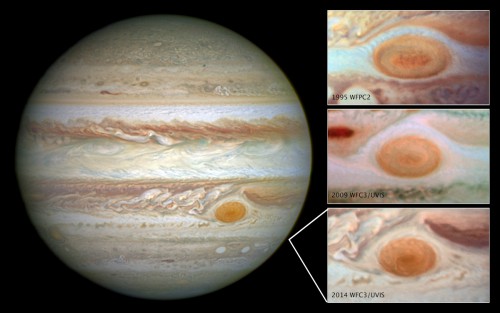
Image Credit: NASA/ESA
Yet, what could possibly be described as Hubble’s most exciting observations of the whole Jovian system were those regarding the planet’s four Galilean satellites. Not long after the space telescope’s optics had been corrected back in the 1990s, it provided fascinating views of new eruptions on the volcanic moon Io, detected ozone molecules on Ganymede—which provided evidence that more interesting oxygen-based chemical reactions could be taking place on the moon’s surface—and identified the presence of an extremely tenuous atmosphere of molecular oxygen around Europa, another fascinating Jovian moon which is thought to harbor an underground global ocean of liquid water. This prospect was strengthened considerably in late 2013, when Hubble detected traces of water vapor coming off Europa’s south polar regions, which scientists interpreted as evidence for the possible existence of water plumes, not unlike those seen on Saturn’s moon Enceladus. As if not wanting to be outdone by its celestial sibling, Ganymede revealed tantalising hints of its own potential habitability to Hubble, when the latter uncovered evidence for the existence of a saltwater ocean below the moon’s surface. Such findings only bolster the case for the presence of potentially habitable environments and even life in the cold regions of the outer Solar System, an expanse which was previously considered of being utterly hostile to biology. “NASA science activities have provided a wave of amazing findings related to water in recent years that inspire us to continue investigating our origins and the fascinating possibilities for other worlds, and life, in the Universe,” says Ellen Stofan, chief scientist for the space agency. “In our lifetime, we may very well finally answer whether we are alone in the Solar System and beyond.”
The Majesty of A Ringed World
We may have become accustomed nowadays on the constant stream of spectacular images of the magnificent Saturn and its moons, courtesy of NASA’s Cassini spacecraft, but the Hubble space telescope definitely has its share of important observations of the sixth planet from the Sun as well. Even before the first Hubble servicing mission in 1993, the orbiting telescope was already providing scientists with detailed views of Saturn’s rings and various atmospheric features, long before Cassini had reached the ringed world. Just a year after it was launched, Hubble had detected a white planet-wide storm covering Saturn’s entire equatorial region, an atmospheric phenomenon which repeats itself approximately every 29 years, when the planet’s northern hemisphere enters summer. This gigantic storm system, better known as the Great White Spot, was briefly imaged again in 1994 with Hubble’s corrected optical system, allowing scientists to discern the storm’s intricate influences in the surrounding atmospheric layers.
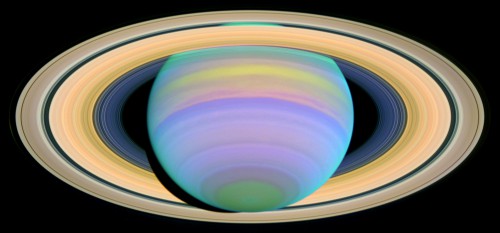
Hubble’s observations of Saturn’s aurorae have proved to be of equal importance to planetary scientists, allowing them to monitor them extensively in ultraviolet wavelengths during the course of more than a half Saturnian year. These studies revealed that Saturn’s aurorae share several similarities with those of other planets in the Solar System, yet are also quite unique at the same time, exhibiting features that are seen nowhere else in the Solar System. More recent observations conducted during the last couple of years returned stunning images of the auroral activity on the ringed world, allowing scientists to confirm a long-held theory which posited that Saturn’s bright aurorae are mostly driven by the collapse of the planet’s magneto-tail, when powerful eruptions from the Sun slam onto Saturn’s magnetosphere. “These [latest] images are spectacular and dynamic, because the auroras are jumping around so quickly,” said Dr Jonathan Nichols, a planetary scientist at the University of Leicester’s Department of Physics and Astronomy in the UK, following the publication in 2014 of the first results of a dedicated Hubble three-year observing campaign of Saturn. “The key difference about this work is that it is the first time the Hubble has been able to see the northern auroras so clearly. Our observations show a burst of auroras that are moving very, very quickly across the polar region of the planet. We can see that the magneto-tail is undergoing huge turmoil and reconfiguration, caused by buffering from solar wind. It’s the smoking gun that shows us that the tail is collapsing.”
Even though NASA’s unmanned Galileo and Cassini space probes have returned a treasure trove of data while orbiting Jupiter and Saturn respectively, the Hubble space telescope has nevertheless kept its rightful place as a leading observatory in the field of planetary science. During the last 25 years, it has allowed astronomers to considerably advance our knowledge and overall understanding of the Solar System, in ways never dreamed of when originally designed in the 1970s and ’80s. “During the run up to the [Hubble launch] mission [in 1990], there was a sense certainly among my fellow crew members and me that Hubble was going to be something special,” NASA’s Administrator Charles Bolden told AmericaSpace’s Emily Carney, while commemorating Hubble’s 25 years of unprecedented, cutting-edge science. “We didn’t know, however, how special—frankly, I’m not sure anyone did. By any measure Hubble has exceeded even our wildest expectations.”
This fact became readily evident with Hubble’s exploration of the vast expanses of the outer Solar System beyond the orbit of Saturn.
You can read Part 2 here.
Below are some of the best images of various Solar System vistas, taken by the Hubble Space Telescope:
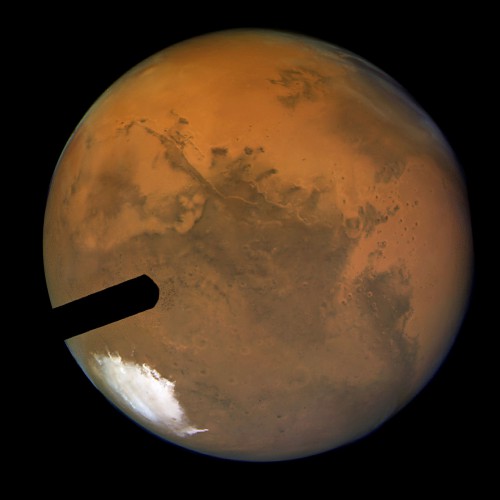
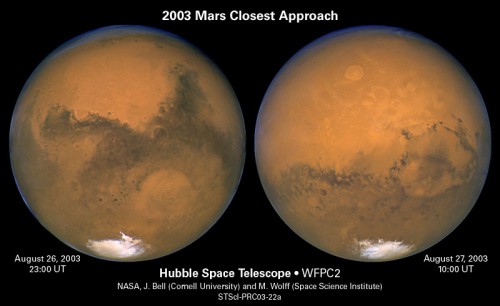
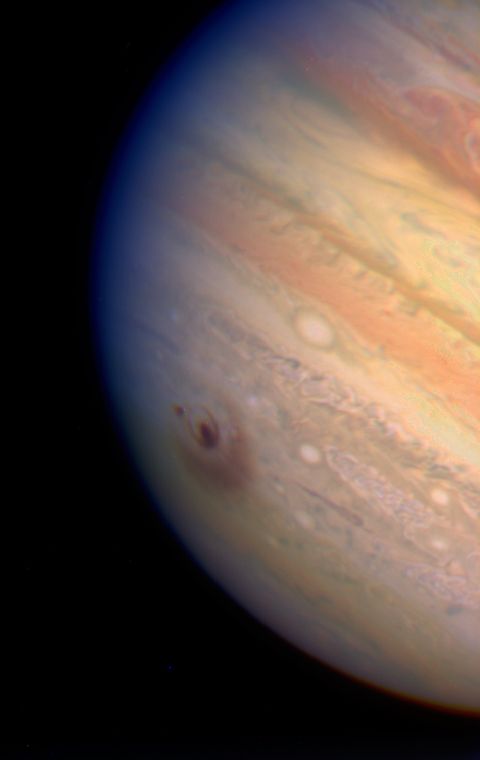
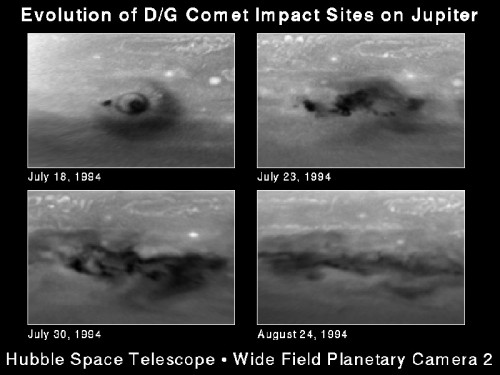
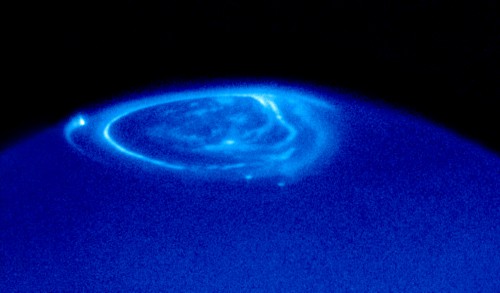
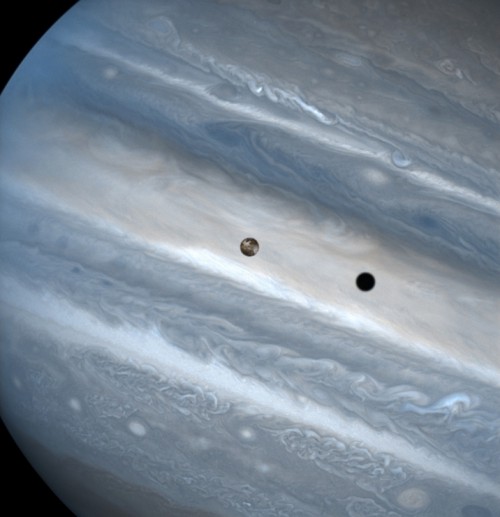
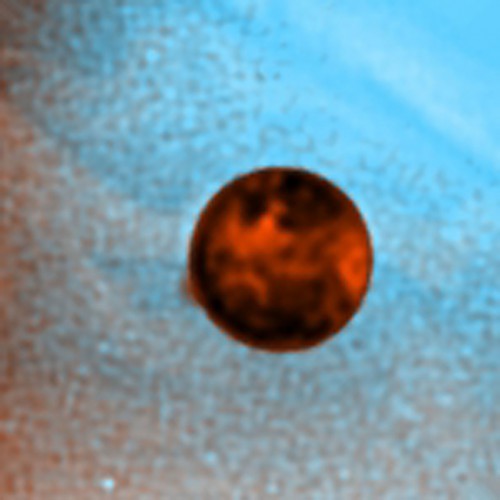
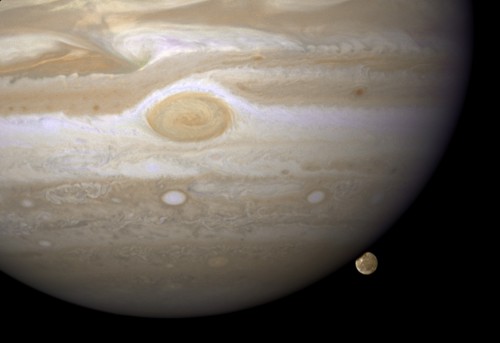
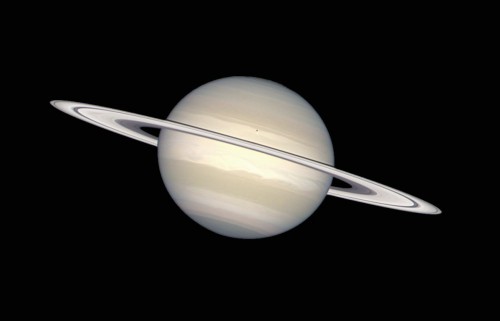
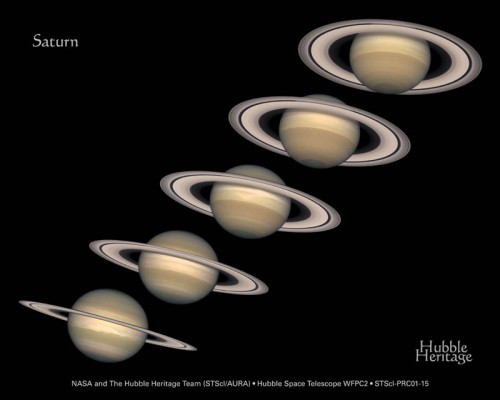
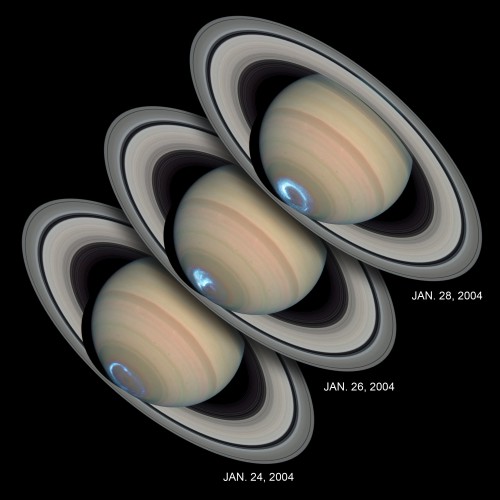
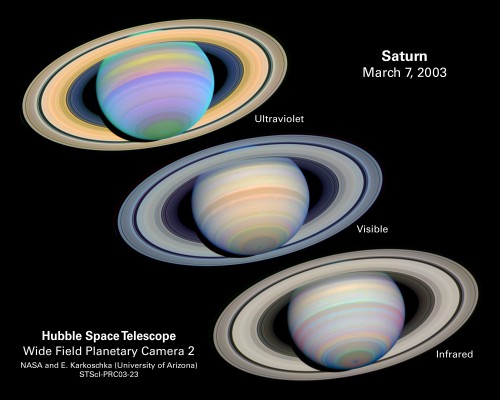
Want to keep up-to-date with all things space? Be sure to “Like” AmericaSpace on Facebook and follow us on Twitter: @AmericaSpace




One Comment
One Ping
Pingback:Shedding New Light On the Solar System: Celebrating 25 Years of Hubble Science (Part 2) « AmericaSpace